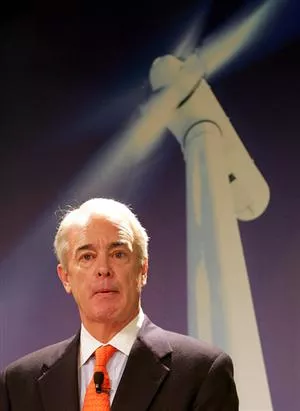Thursday, September 22, 2011
Boomer with Attitude "Where's the renewable energy?" — a key question for Duke Energy at North Carolina Utilities hearing
Posted By John Grooms on Thu, Sep 22, 2011 at 7:03 AM
Where’s the renewable energy? That’s become a key question at the N.C. Utilities Commission’s (NCUC) hearings this week on the proposed merger of Duke Energy and Progress Energy. A long list of advocates and attorneys have shown up to oppose the merger. Some of them focus on the 2,000 lost jobs the merger will bring — a significant point in today’s miserable economy. Many of the merger’s critics, however, are zeroing in on the lackluster performance of both companies when it comes to increasing the amount of energy they generate from renewable sources.
Yesterday, Duke CEO Jim Rogers would not commit his company to creating more renewable energy than the state requires, which is to hit 12.5 percent of their electricity generation by 2021. Rogers told the commission that although Duke Energy is “a leader” in solar and wind power, mostly in other states, North Carolina isn’t suited to those types of power generation. Utilities Commission chairman Edward Finley Jr. disagreed with Rogers, noting that his group is currently reviewing two wind-power applications from other companies.
Rogers’ argument is the same tired spiel he made before the same commission in March, when he told the NCUC that "North Carolina doesn't have any wind [energy potential]." So here goes the same counter-argument we’ve written before:
Rogers' claim was, and still is, astonishing, coming as it does after two well-publicized national studies concluded that North Carolina leads the East Coast in wind power capacity. One of the studies said North Carolina is one of three states, along with Delaware and Massachusetts, that are capable of generating all the power they need through offshore wind power alone. Those studies are in addition to Obama administration plans to accelerate offshore wind energy development in the mid-Atlantic states, including N.C.
Rogers said yesterday that Duke has no plans for wind power in N.C. because “the wind doesn't blow here" enough, except on mountain ridges and coastal waters. Well, Jim, how about using your political connections to make it easier to expand in those areas? If Rogers really wanted to expand Duke’s renewable energy output, nothing is stopping him from lobbying the right folks to make it easier to put turbines on our mountain ridges and in our coastal waters. If you need an example of how it can be done, look to where it’s already being done, specifically the United Kingdom. Last September, the UK cranked up the world's largest offshore wind farm which, when added to the UK's previous wind power capacity, could power all the homes in Scotland. The Thanet project cost $1.4 billion, and was financed by an energy fund, which funnels money collected from polluting industries to renewable energy resources. That’s a great idea for America, and it’s one we’d like to see Rogers and his company, merged with Progress or not, pursue in Washington — energetically.
Coincidentally, the New York Times today is conducting an online discussion about why the US has fallen behind the rest of the world in renewable energy. It’s an eye-opener that we hope N.C.’s two energy giants pay attention to.
Speaking of...
Comments (2)
Showing 1-2 of 2














